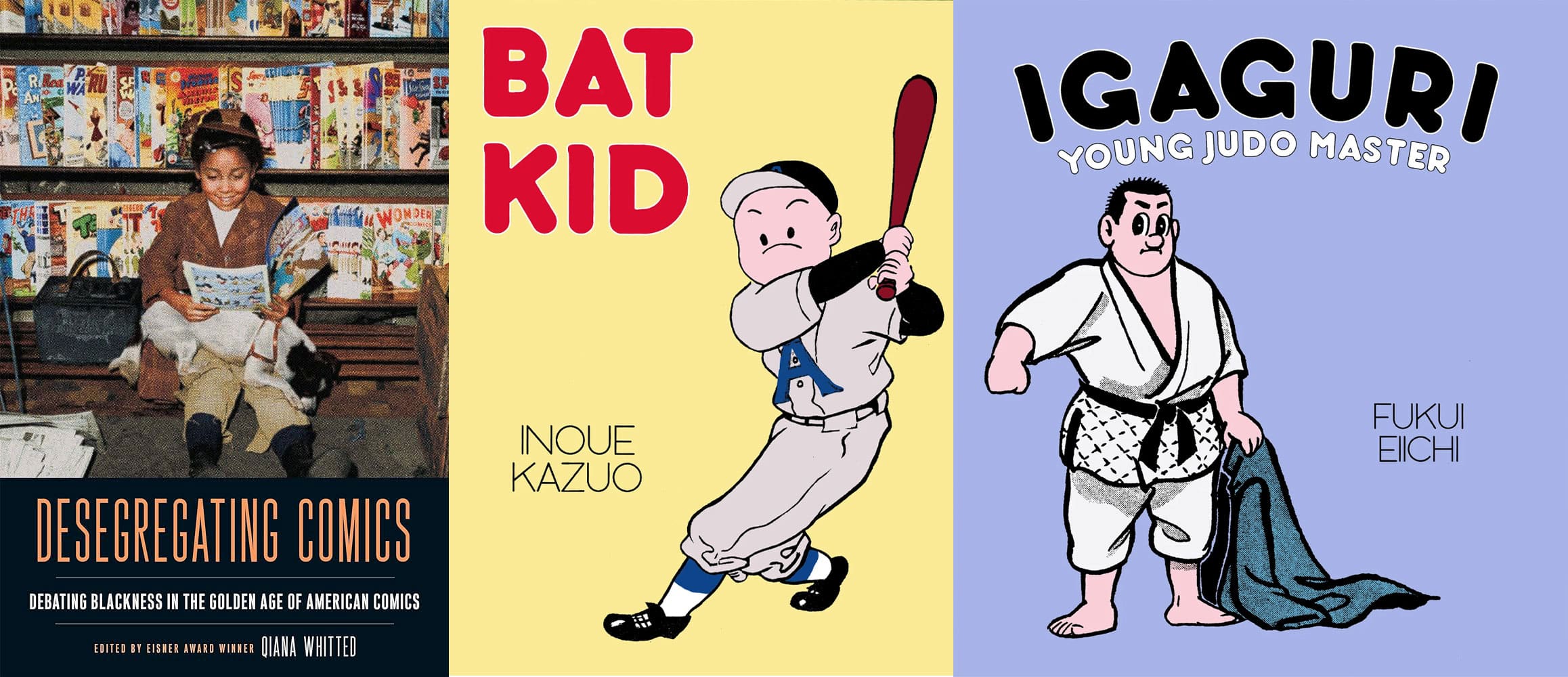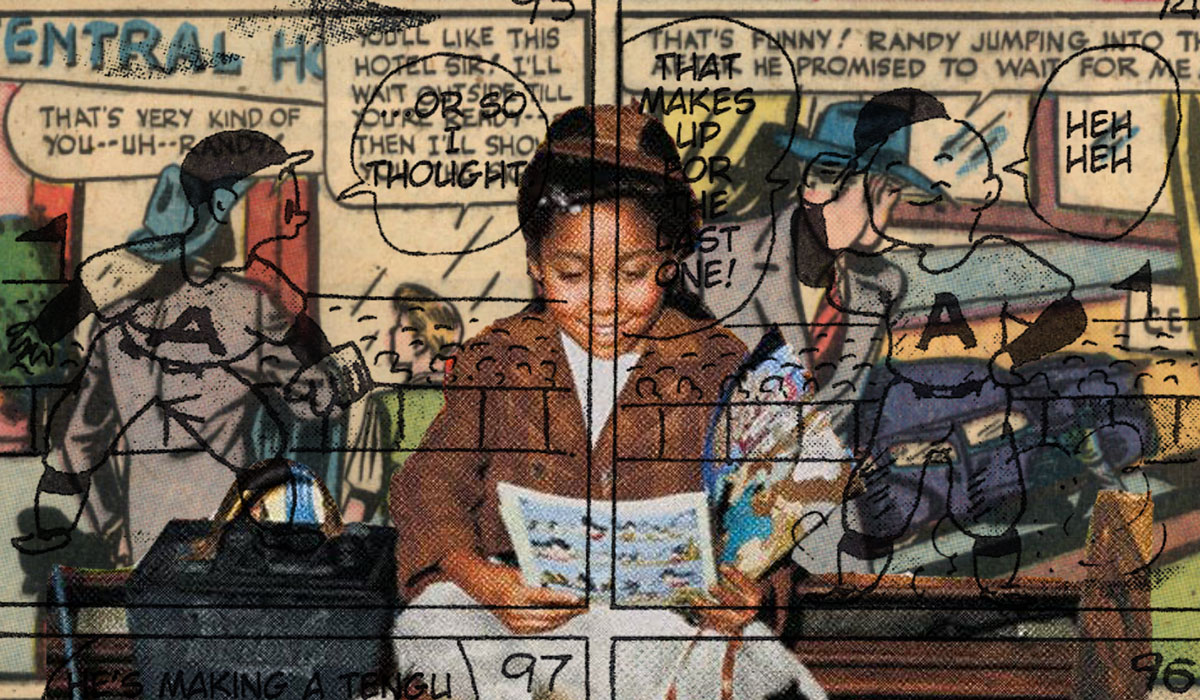
Critical Thinking is a new column that analyzes academic writing about comics. Arpad Okay has degrees in education and journalism, but also writes in third person on the internet. If there are deductive flaws, they are reflections of my analysis and not the source material.
Bat Kid
Written and illustrated by Kazuo Inoue
Translated by Ryan Holmberg
Essay by Ryan Holmberg
Published by Bubbles Zine
Igaguri: Young Judo Master
Written and illustrated by Eiichi Fukui
Translated by Ryan Holmberg
Essay by Ryan Holmberg
Published by Bubbles Zine
Desgregating Comics
Edited by Qiana Whitted
Written by Ian Gordon, Nicholas Sammond, Andrew Kunka, Rebecca Wanzo, Chris Gavaler, Monalesia Earle, Blair Davis, Eli Boonin-Vail, Carole Tilley, Qiana Whitted, Brian Cremins, Mora Beauchamp-Byrd, Phillip Cunningham, Jacque Nodell, Julian Chambliss, and Mike Lemon
Published by Rutgers University Press
Have you ever read more than one book at once and realized that they are talking to each other in your head? Qiana Whitted’s anthology of essays examining Black contributions to the medium during the golden age, Desegregating Comics, was something I’d been reading on the train to and from work. The Kazou Inoue Bat Kid book I read in a single sitting the night it and Eiichi Fukui’s Igaguri: Young Judo Master came in the mail. Bat Kid, the manga, knocked me flat. Inoue’s illustrations evoke Geo McManus and Jazz Age cartoonist aesthetics, and his warm storytelling is very My Neighbors the Yamadas. The essay at the book’s end, by translator and publisher Ryan Holmberg, also strongly recalled something I really enjoyed. An essay I’d read earlier that day, on the way home.
So it’s Holmberg’s essays that I wanted to write about here, not the manga he translated, and how they relate to the ones in Whitted’s collection from Rutgers University Press. The writing in these Bubbles Zine books is a crash course on the history of postwar Japanese publishing as well as a wealth of details on the innovations Fukui and Inoue brought to comics. Successful in some ways, hindered in others, their work existed at the crux of intention, industry, and institution. So too were the golden age artists covered in Desegregating Comics. Japanese cartoonists struggled with cultural censorship from outside and nationalist movements within. Black creators had to express themselves through an industrialized art whose visual language actively pursued their dehumanization.
Together, these works show that the struggle for cultural representation in comics have similar issues in a broad sense, but are expressed quite differently in individual cases. Black creators faced an industry where minstrelsy was aesthetically institutionalized and real life opportunity was marginalized. To see themselves reflected in the comics of the times sometimes meant Black artists had to use self-denigrating archetypes, but in doing so created the first alternative heroes. Japanese creators, in the aftermath of the Allied victory of WWII, saw aspects of their culture censored by the new standards of occupation. At the same time, some manga artists who conformed to Allied respectability politics in an attempt to culturally subvert comics made under occupation were doing so because of a muscular art resistance movement tied to nationalism. Both Japanese and Black comic creators during this period found ways to earnestly represent themselves, and that representation is complicated.
REPRESENTATION
Early works from Black artists were during a period when individual contributions weren’t considered by most readers, enabling them to produce stories for mainstream publication in relative anonymity. Being credited for work at all was a luxury, let alone having the ability to take a comic in a direction other than the editor’s desires. Portraying their identity realistically was not in the realm of possibility. The contributions of Black creators were foundational to the aesthetics of horror comics- Blair Davis’ essay on Alvin Hollingsworth art in comics like Eerie and Beware traces a line from Hollingsworth pre-code horror shadows to the sculptural blackness of negative space in Mike Mignola‘s Hellboy inks- but they were also forced to perpetuate anti-Black “othering” stereotypes. Black creators weren’t expressing their personal perspective through the plots of colonial adventure, jungle, or horror comics. But their artistic values set standards for what was to follow.
At the same time, there was a Black cop taking down jazz-coded gangster hoodlums, created by Black artists Orrin Evans and John Terrell for All-Negro Comics. This comic had Black artists telling stories about superheroes, cowboys, even jungle comics with slapstick buffoon sidekick hijinx. Black folks were there from the beginning with comics: they grew up on them, like everyone else in America, and wanted to see themselves in the medium they knew and loved (and contributed to). Black characters in comics first took to the spotlight during a period of respectability politics about identity that divided communities. Struggling for recognition as citizens within a racist system, several golden age Black comics that were successful were part of an attempt to create a new identity for African Americans. It wasn’t free of the minstrel imagery of the past, but reformed it. Detective Ace Harlem found his antagonists hanged by their own zoot suit chains. Middle class Black folks shared an everyday domestic common ground with white society and golden age comics were a tool of their assimilation. Comics were for everybody.
Contemporarily (as, I would imagine, in its day) this raises questions about creating stories for everybody. Who is everybody? The cop, the cowboy, and some would argue the superhero all represent the violent force protecting a status quo- one that doesn’t extend equal justice to Black people. Is making sure all the jails are full a priority of the oppressed? Comics publishers didn’t think so. Davis cites ephemera preservation advocate Craig Yoe and looks directly at Hollingsworth’s source material in Blue Beetle to find Bronze Man with a bronze mask that is neither bronze in material nor color. Why bronze? The theory is Bronze Man was intended as one of the first Black heroes with fantastic powers of the golden age, but his editors couldn’t picture a world where superheroes were people of color. Today, many Black superheroes who see print are considered alternate versions, sparking controversy for “replacing” their white source. Rebecca Wanzo says this affirms the biased world the superhero protects and perpetuates. Beyond the nature of dated, loaded editorial categories, however, there was still a cultural divide Black comics inflamed. Does an affluent community’s idealized version of the community representing everyone’s ideals with equity?
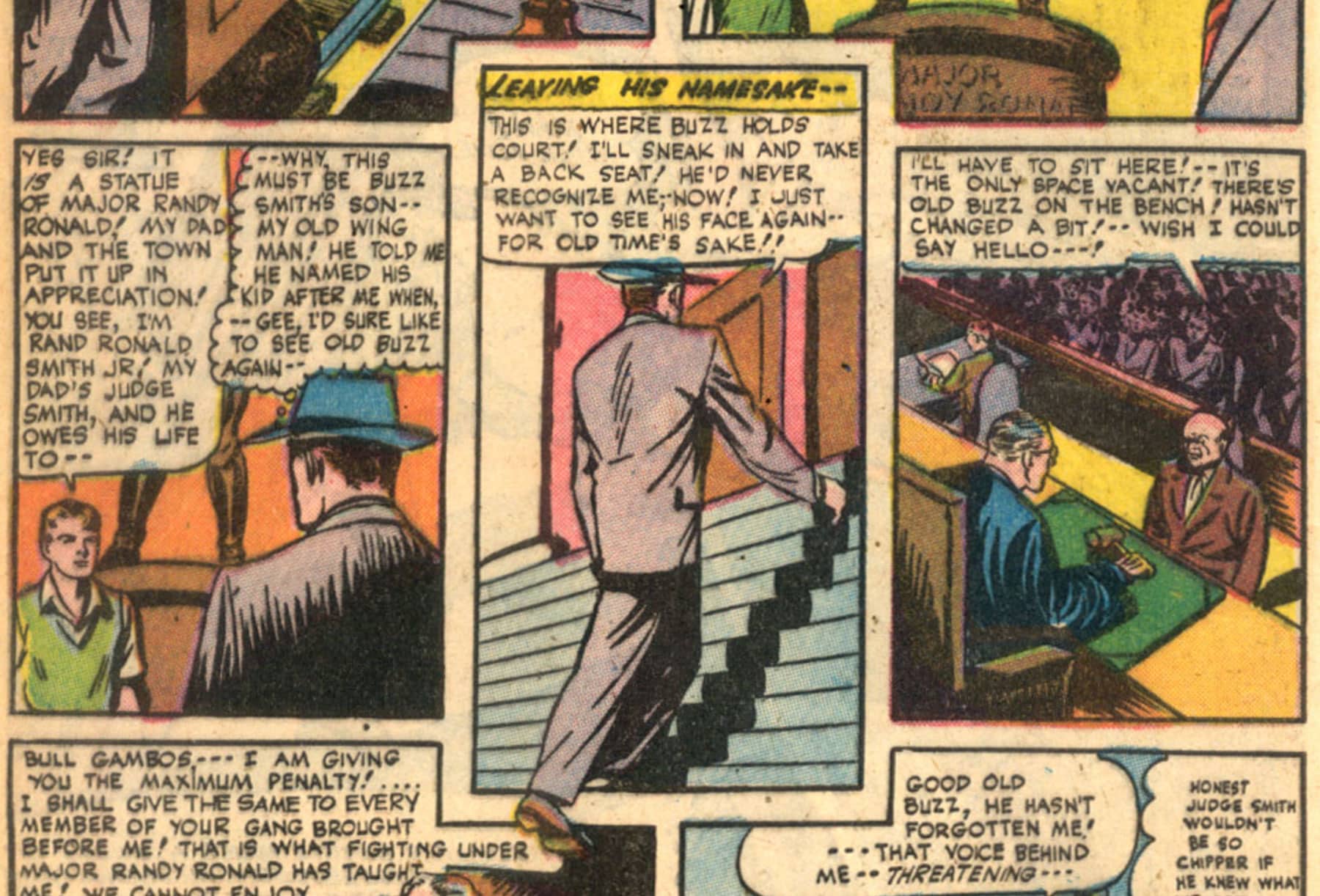
The Bubbles Zine historic manga reprints are also focused on good behavior comics, work made in an industry setting with edicts beyond the individual cartoonists’ influence. Inoue’s baseball manga Bat Kid established an approach that followed occupation guidelines in the aftermath of WWII while highlighting authentic facets of the culture being censored. Baseball’s popularity in Japan precluded the Allies-created boundaries in manga publication, so Bat Kid is in part a celebration of prewar Japan as well as a window into postwar life. What resonated with kids was seeing an everyday family and a protagonist who was like them and pursued something they loved. Bat Kid is genuinely wholesome, a young man who makes the right decision under pressure first and a star player second.
Eiichi Fukui on the other hand embraces the muscular nationalism hype pushing for Japanese culture in Japanese comics. Again, the active reader must ask, which Japan’s Japanese culture? With his judo manga Igaguri, Fukui champions the power of discipline, and the developed, balanced mind that comprehends the meaning of good sportsmanship (throwing a dude across the room). Its aim was to return the power of judo- and the intellectual sophistication to wield it responsibly- to the nation who historically practiced it. To transfer its power to a disarmed Japan. Judo (and kendo) were taboo but baseball, with its heavy American connotation, was acceptable. Fukui’s sport was connected to nostalgic notions of national identity, where Inoue’s was nostalgia for national life.
Hollingsworth modeled Kandy, the rough-and-tumble bombshell auto mechanic, in aesthetics and in spirit after jazz singer Lena Horne, a high society advocate for equality and a Black icon. Mora Beauchamp-Byrd’s examination of Hollingsworth’s contribution to the romance genre explores the cartoonist’s politics in a totally different way than Davis’ analysis of horror covers. Hollingsworth wasn’t alone in creating something for Black readers who wanted to see themselves as a Hollywood superstar. Eli Boonin-Vail also wrote about Jackie Ormes, who carved out a space for Black women with Torchy Brown, Kandy’s predecessor on the comics page. Torchy and Ormes were pioneering Black representation in comics, and connecting it to Black presence in the real world of fashion, and Black contributions to journalism. But Black integration from the economic top down leaves the same people behind who have been marginalized the most. The creator, the comic, and the context of its release all need to come together for an accurate understanding of representation’s part in an industrialized, institutionalized art like the funny pages.
GENREFICATION
Addressing for whom comics are intended opens up another dialog between Bat Kid and Bronze Man: the “genre-fication” of comics as the medium moved from the newspaper to being serialized in comic book format. Black comic strips saw a boom in readership and cultural relevance during the golden age that was tied to the popularity of Black newspapers. The comics section in the paper was a communal space, every strip looked at by the entire household. Beauchamp-Byrd’s essay highlights genre-hybridity in comics like Kandy being both revolutionary and distinctly of its time. There was a demand for strips to defy genre constraints. Romance comics featured action and intrigue– Torchy and Kandy knew how to throw a punch as well as serve cheesecake. The strips by Ormes and Hollingsworth each followed a Black woman who could handle herself in a pulp world of men’s adventure, presenting a familiar structure with uncommon race roles and characterization that defied established conventions. Torchy’s world felt real to its readers, realer than the caricatures of both Black people and women that were ubiquitous elsewhere. Inspired cartoonists took the opportunity that genres blending together offered and used it to give agency to characters usually barred from that kind of story.
And here, where all genres cross and blend, Tezuka takes the stage. Having every single type of story that exists play out panel by panel in the same manga was Osamu Tezuka’s signature through and through. A reader could expect tears, gags, action, and romance all on the same page. Personally I love its application combining swashbuckling adventure with fairytale romance in his 50s shōjo work like Twin Knights or The Storm Fairy. Holmberg sees both Bat Kid and Igaguri as series that developed manga storytelling along standards separate from what Tezuka was up to. Part of that was the tremendous influence of Disney on Tezuka, and how Tezuka’s manga are largely set in a totally cartoon world free from rules (or restraints). Inoue and Fukui weren’t telling stories set in a fantasy world, wheeling from slapstick to the operatic. Bat Kid established a naturalistic mood, comedic and unassuming (Yasujirō Ozu’s Good Morning drawn by Hergé) and stuck to it. Inoue’s focus was on telling one specific type of story- baseball- and its success generated interest in more baseball stories, and a niche was established. Baseball comics.
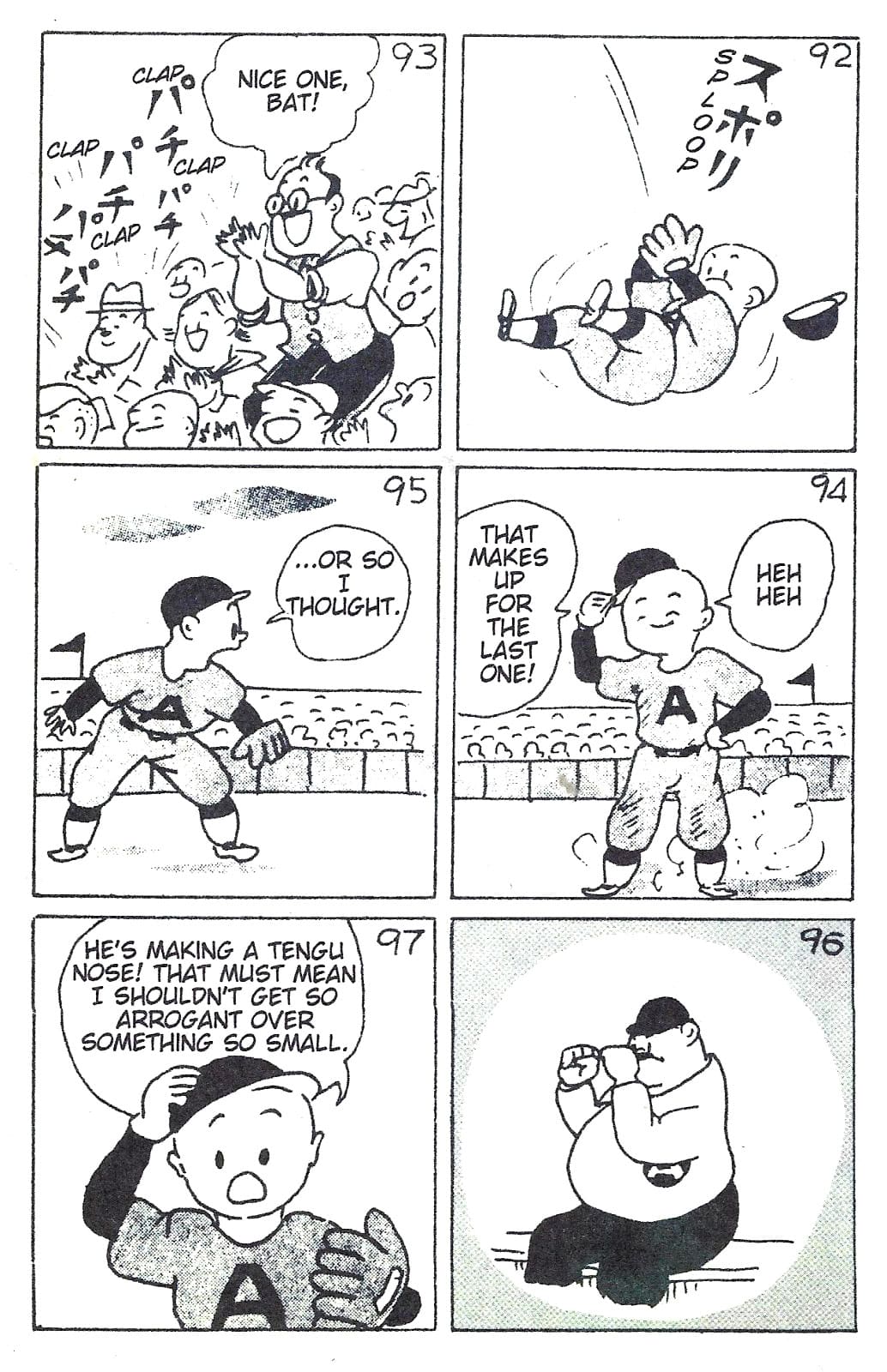
Early and mid-period golden age comics in the US were similarly curated and marketed as genre books. Horror, Western, crime, romance, and war titles were all supposed to be thought of as different kinds of comics, catering to individual taste in different kinds of readers, despite their frequent shared themes and stories. Are war comics not also horror stories? Even Bat Kid in execution is similarly fluid in genre, often more a slice of life comic than baseball manga, though it’s decidedly and with some historic importance filed under sports. Igaguri on the other hand would focus on capturing the sport, leading the genre towards its future cornerstone characteristics. Fukui’s judo comics were about the ferocious, competitive spirit and deep respect for the rules of the game that makes for all-star players. The passion and ferocity of competition, the glory of winning, the humbling lesson in loss. As comics and manga genreficated, these were the kind of conventions that became what set a sports comic apart from a mystery series or a superhero adventure. Inoue was more like Mitsuru Adachi’s genre-defiant romance comic, Cross Game. The story of peoples’ lives, connected by a pastime. Bat Kid spends more time in the “off the diamond” comings and goings of a boy who loves baseball than playing baseball. Categorical analysis describes where Bat Kid fits into the story of publishing, but it engages the imagination of its readers by accurately reflecting everyday existence.
HEURISTIFICATION
No one needs to know the story behind a piece of art to have a vivid and valid reaction to it. And yet fully understanding comics requires looking beyond the page. The whole story is not only what was published, it’s what was allowed to be published, and how constraint shaped stories, or prevented them. Skip to the 2000s and the same problems exist, but now primary accounts of their imposition are available. Ron Wimberly‘s 2015 piece for The Nib on coloring She-Hulk and Ho Che Anderson interviewed just last year about Luke Cage show the limitations imposed on Black representation aren’t rooted in acute instances of bias but are chronic institutional issues. As the golden age waned, many Black creators moved away from the comic book industry in order to be able to freely express themselves through their art. Artists would become magazine illustrators and political cartoonists, another practice of comics-making kept as culturally distanced from comic books as newspaper strips. Rebecca Wanzo’s essay desegregating genre argues comics are a multidisciplinary practice, that have influence in and are influenced by other art forms. An artist’s intention is best analyzed from an intersectional perspective.
Heuristic analysis allows work in one medium to influence another through the experience of the artist. Categorical definition that excludes is great for identifying traits but disastrous for discussing inspiration or intention. The artists’ motivations, the times they lived in and made art in reaction to, the obstacles and opportunities those times afforded them. All that factors into meaning, to say nothing of the work itself. Sadly, it’s easier to trace the influence of other mediums on comics, with their established vocabulary and elocuted concepts already in place, than it is to identify comics’ influence on mediums outside of illustration like film or sculpture.
Before manga would take over the postwar print market, a form of illustrated storytelling called emonogatari was the backbone of the industry. Similar to Prince Valiant, the story was told in prose to the side, with a series of pictures capturing the described moments- though Superman coming to Japan via American sailors’ comic book collections saw speech bubbles begin to integrate text and image into a single space. Emonogatari though defined by the inclusion of illustration was considered prose and serious literature, not light entertainment. Postwar censorship of violence and mature themes in the Japanese publishing industry created an emonogatarial gulf in magazines that good kid manga filled. Cartoonists like Fukui and Inoue, like the Black artists who contributed to All-Negro Comics, submitted to an unwanted type of representation to enable cultural preservation and integration. Black creators left comics to pursue art where they could express themselves. Early Japanese cartoonists moved to comics from other more developed mediums of expression, and brought with them to manga something deeper than such oversight intended.
The experience of individual cartoonists informed their visual style. Bat Kid was shaped by Inoue’s fascination with comics as a union of image and sound. Like the radio, comics were the experience of being told a story that conjured images and actions out of the imagination. The full body depictions of characters within each frame, accompanied with a story told to the audience, evokes aesthetic approaches like in emonagatari illustrations, their woodcut predecessors, as well as other earlier Japanese multimodal storytelling practices like shadowbox images. John Pham’s nearly impossible to find third issue of Epoxy juxtaposes shadowbox storytelling with traditional comics to great effect- and juxtaposes that against how the emcee and the producer fit together to make storytelling in hip-hop work. Igaguri on the other hand was shaped by Fukui’s experience as a storyboard artist and animator before he worked on manga. His comics had cinematic framing, they look like manga today, like comics, and not comic strips. Imagine shonen manga (or sports comics) if no one had ever incorporated the visual dialog of shot-countershot confrontations into the language of comics. Igaguri’s “Mountain Storm Vanquished” is a John Woo movie in a Gasoline Alley universe.
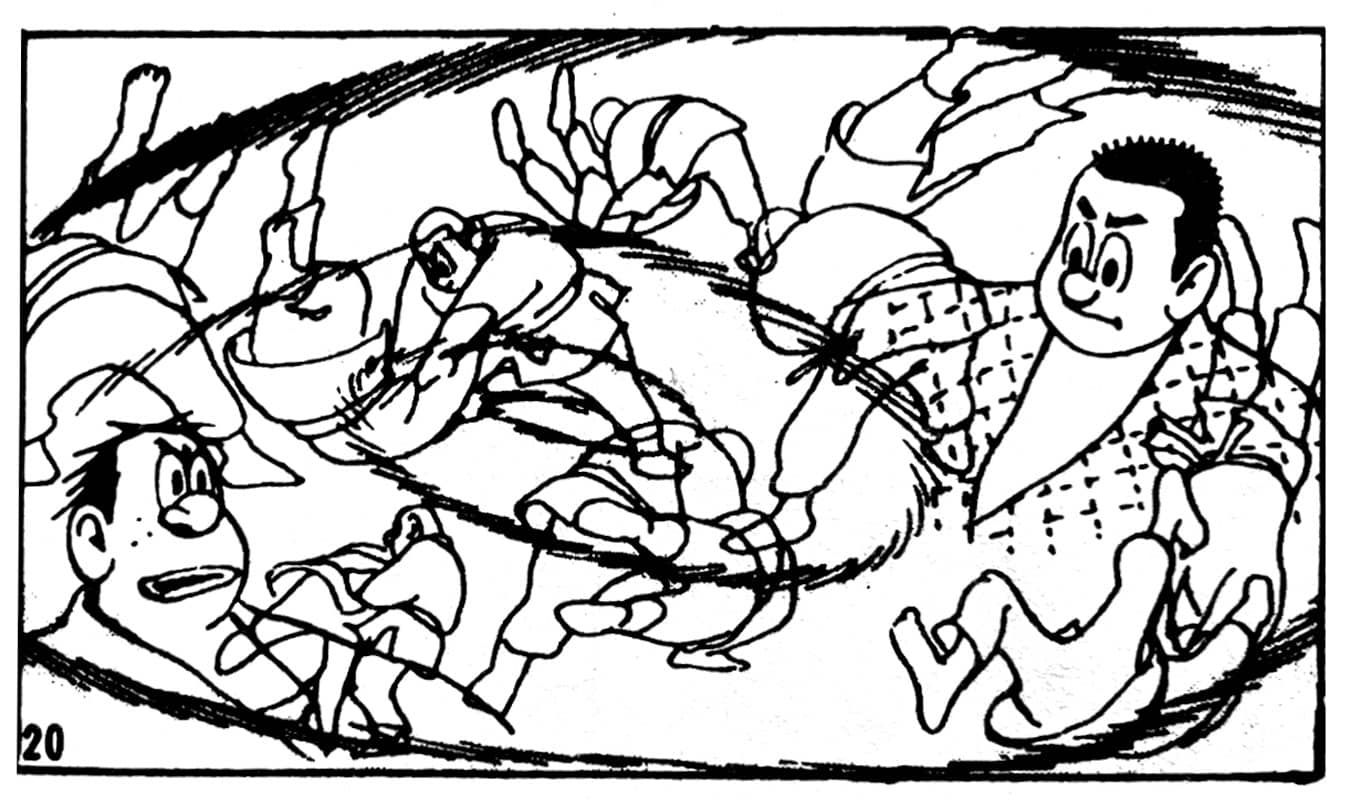
SHADOW BOOKS
In one sense, shadow books are what come from ephemera and time. Much of this stuff isn’t widely read because there aren’t any copies left to read; very few issues from the golden age survive compared to the number printed. Lin Carter’s A Look Behind the Lord of the Rings (if I may tangent slightly) is a work of armchair academia that traces JRR Tolkien’s references back to their sources in romantic fantasy and epics. Carter observes that, while many epics have been lost to time, the Attic compulsion to catalog produced critical responses to otherwise lost works that did survive. Holmberg’s essays and supplements to the Bubbles Zine historical manga are full of archival samples, teasing the existence of the Little Punks Detective Brigade, or the emonogatari Hayao Miyazaki loved to read when he was growing up (it shows), but just that. Tiny glimpses into Holmberg’s collection. Beyond Bat Kid lies a murderers’ row of the physically unobtainable. Desegregating Comics is the same way, the text sewn with example images obtained through academic, regulated access. The golden age was also nigh-devoid of artist accreditation, rendering some artists fantastically rare and practically secret both. Very little of this stuff appears to be digitized, either, outside of the covers of physical volumes being sold second-hand. Bronze Man was a nobody compared to Torchy Brown when each character saw print, but he appeared in Steve Ditko’s Blue Beetle superhero comic, and she’s a romance newspaper strip. So you can find all of Bronze Man’s exploits and barely any of Torchy Brown’s. What Whitted and Holmberg feature largely falls outside of what’s getting scanned.
Holmberg also addresses how the scarcity of books that are recognized as important can add to the shadow they cast. A book being flamboyantly overpriced (if not completely unavailable) increases the hype surrounding it but doesn’t reveal much about its quality or importance. The first issue or appearance isn’t always the most significant one. Jacque Nodell’s Desegregating Comics essay talks of scarcity: the only public collection of the complete four issue run of Negro Romance is in the Library of Congress. The quality of the period Black romance comics I’ve had the good fortune to read definitely piques my curiosity about the series. But the fourth issue is a reprint of the second issue, the product of comic companies acquiring each other as the postwar market changed, so not of value to the reader like me in the same way it is to the catalog completist collector. There being only three issues of a comic and barely anyone having access to them are the conditions that create tertiary accounts like the one you’re reading.
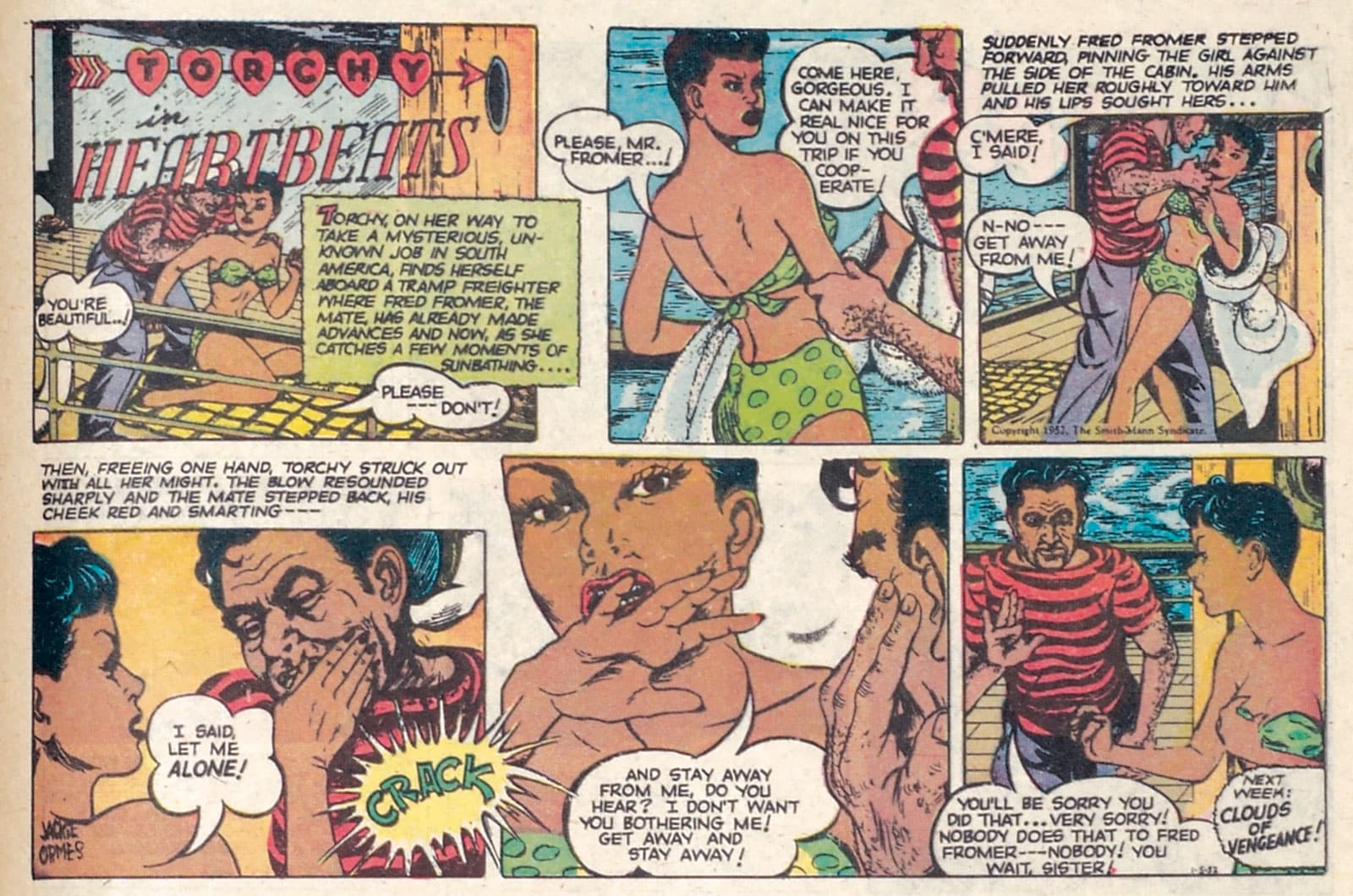
Issue four of Negro Romance was a late Charlton reprint (a publisher aiming to stand out once the golden age boom busted with contemporarily relevant reading material) of an early Fawcett original (a publisher riding the boom with dozens of other niche romance comics in print, as well as dozens more comics of all stripes for all interests). The second issue was reprinted as the fourth so that Charlton could maintain publishing rights over an imprint, does that reflect the motivations of the original creators behind Negro Romance? They probably wouldn’t begrudge the further circulation of their series allowing more people to become readers. But comics instead of creators profiting from their publication is a real problem not to be written off. Creators’ contributions are the essence of the form, but they are often excluded from the decisions made about their art.
Other shadow books never came to be in the first place Whitted frames the history of Black comics within Michael Hanchard’s concept of racial time. The inequity of access across community lines meant Black cartoonists had to find seats at a table that was already filled by artists with fewer social obstructions and hosted by an editorial apparatus that deprioritized Black inclusivity. To tell their stories, Black creators had to generate resources white creators already had in place. They had shorter windows in which to prove themselves against over-scrutiny from a white publishing establishment; Black comics must succeed unequivocally and immediately or lose the opportunity forever. The second issue does not go to print. Black comics are a story of “fits and starts” instead of long continuity. The single issue of All-Negro Comics, to say nothing of the three and a reprint Negro Romance run, is a victory.
EDELMANIFESTATION
Holmberg writes that the sea change from emonogatari to manga never seachanged back because manga was allowed to grow up alongside its readers. It was conceived of as a medium for childrens’ fare during its initial postwar boom, despite comics for adult readers already having been popularized for a decade in Japan. The art itself couldn’t be restrained, developing through practice, establishing more sophisticated methods of storytelling and subsequently growing able to tell more meaningful stories. Was it cartoonists’ success and experience enabling them to execute more personal work? The fans maturing and publishing recognizing the market their success with young readers had created? Is it a false distinction, with the earliest comics to undergo genrefication still at this stage in their development essentially the same as their strip forebears that could address an entire household of diverse reading sophistication? There’s an allure to interpreting a comic from another age (one that doesn’t guarantee answers). Miscalibrated color dots on yellowing paper remind the reader the story belongs to another time, demanding a close reading that we reconcile against our place in the world. And with that feeling, the distance, a frustration that so much of it is inaccessible. No one wants to draw conclusions from secondhand truth.
Whitted has curated a group of voices that are aware of who is missing from the world of comics. Bat Kid and Igaguri both appealed to their readership by portraying lives they could recognize. They found a way to play within the rules but against the intentions of culturally suppressive oversight. The publishing landscape in America was different. Brian Cremens’ essay on how Black identity was represented in comics (another victory won with baseball) covers negative but normalized as well as positive portrayals. Captain Marvel’s Black sidekick Steamboat, for example, was depicted with minstrel characteristics until a group of organized young comics readers in 1945 called the Youth Builders appealed to the publisher to discontinue the character’s use. The idea of comics maturing with their readers falls short when only some perspectives are allowed meaningful representation. Black comics by Black creators were a rarity. Minstrelsy, on the other hand, was integral to both character types and editorial categories that were cornerstones of comic strips, early comics, and cartoons. The other predominant golden age influence on comics, pulp fiction, was also highly racialized: lionized white masculinity clashing with the unbridled ferocity of the imagined “other.”
One wonders how individual expression can thrive in an industry riddled with institutional inhumanity. To start with, the industry should draw a distinction between operating to serve a community and expecting profits to increase indefinitely, and redefine success as satisfying the former. A crowdfunded book only needs a few hundred people to ensure its publication, while mainstream comics that appeal to more readers by an order of magnitude are in a constant state of failure and cancellation. Trapped in creative stasis, mainstream stories are forced into reproducing the instantly recognizable in increasingly convoluted ways to stay fresh and yield larger fiscal returns than its previous incarnations (and yet freelance rates remain insultingly unlivably frozen) instead of being free to pursue coherence. Meanwhile, people come together on a small scale and make it happen. This goes back to the golden age, according to the Julian Chambliss essay in Desegregating Comics on the comics distributed through Carousel, a syndicated Black comics insert created for inclusion in multiple Black newspapers. Rather than create something universal, Carousel saw success by creating a network between smaller markets. It was seen as a profitable industrial venture, an opportunity for smaller papers to tap into a wider market, a venue to showcase Black cartoonists. The boundaries of Black storytelling in comics were enabled to push out further, and the readership of higher quality comics grew. There are other ways to do it than the system we perpetuate. We’re doing them! And they work! I don’t think voting with our wallets will get us out of the corner we’re in, but moving away from the sisyphean ambition of endless capital growth is a part of shifting the cultural landscape, and direct support of bespoke storytelling is making positive change towards that goal.
Click here to read more of Critical Thinking.
Related
Discover more from reviewer4you.com
Subscribe to get the latest posts to your email.
